NEWSLETTER 17th Sept 2019
ADVANCE NOTICE OF PROPOSED 2020 OVERNIGHT TRIP TO ROCHESTER
We are exploring the possibility of arranging a group trip to Rochester in Kent, with an overnight stay, visiting the historic Chatham shipyard complex on the return journey. The outward journey would be on Sunday 6th September 2020, staying overnight in a Best Western Hotel in Gravesend and returning on Monday 7th September via Chatham. The cost for half-board and entrance fees for Chatham Dockyard would be £145 per person for double room and £165 per person single room. The hotel books up very quickly and to ensure that we have enough people to justify making this trip we need to know very rapidly how many of our members and friends would be interested in it. Isobel Gill will be asking members at the meeting on Friday 20th to indicate their interest. If you are unable to come to Friday’s talk but you are interested, or have any queries, please contact Isobel Gill on 01926 640426, or email: isabel.mirador.gill@gmail or reply to this Newsletter email.
Launch of CAPTURING KINETON’S PAST: the collected essays of Peter Ashley-Smith
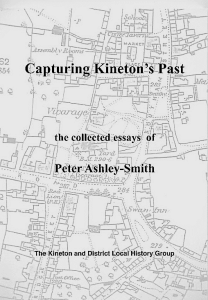 Peter’s local history essays, edited by our President Robert Bearman, have now been printed and members and friends are invited to the launch on October 4th at 7.30 in the Village Hall.
Peter’s local history essays, edited by our President Robert Bearman, have now been printed and members and friends are invited to the launch on October 4th at 7.30 in the Village Hall.
The book presents a fully illustrated and meticulously researched collection of vignettes of over 200 years of Kineton village events and characters. The late Peter Ashley-Smith’s regular articles intrigued and amused the people of Kineton when originally published in the parish magazine Outlook for over ten years.
There can be surely no better tribute to Peter’s major contribution to the appreciation of Kineton’s past than to fulfil his ambition and bring those Outlook articles into book form as a permanent memorial of his work.
Robert Bearman, the Group’s President and General Editor of the publications of the Dugdale Society, efficiently undertook the task of stitching these pieces together into a coherent volume, assisted by Gill Ashley-Smith, with illustrations from David Beaumont’s comprehensive collection of historic photographs of Kineton, and extracts from Peter’s and Gill’s archives.
The result is an attractive 128 page paperback with 55 illustrations, retailing at £9.99. It is obtainable from kinetonhistory@yahoo.co.uk or at the launch.
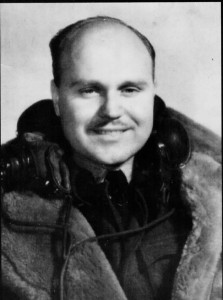 Our first evening talk after the summer break is on Friday 20th September entitled Shadows of the Past: WWII, to be given by Paul and Terry Gaunt, cousins of our Vice-Chairman Roger Gaunt, about the exploits of Roger’s uncle, Phillip “Tubby” Gaunt, as a WWII bomber pilot. Paul Gaunt has written a book about his father’s career, from training to a crash landing in Croatia. You will have to come on Friday to hear the end of that story …..
Our first evening talk after the summer break is on Friday 20th September entitled Shadows of the Past: WWII, to be given by Paul and Terry Gaunt, cousins of our Vice-Chairman Roger Gaunt, about the exploits of Roger’s uncle, Phillip “Tubby” Gaunt, as a WWII bomber pilot. Paul Gaunt has written a book about his father’s career, from training to a crash landing in Croatia. You will have to come on Friday to hear the end of that story …..
If this talk prompts any KDLHG member with WWII recollections they could share please note the national project run by James Holland to collect oral histories of the Second World War (go to WarGen (http://wargen.org). If you have any doubts about the value of oral history then November’s talk by Helen Lloyd should convince even the most sceptical.
Report on 10th August visit to IRONBRIDGE GORGE 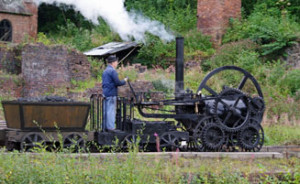 We were looking forward to visiting this World Heritage Site, a cradle of the industrial revolution, which includes Blists Hill Victorian Town, the iconic bridge itself and other historic industrial sites in Ironbridge Gorge, and it did not disappoint. The drizzle which greeted us at Blists Hill quickly evaporated, helped by a quick coffee and visits to the Bank, the grocers, the carpenters shop, the haberdashers (under 40s won’t know what that is!) and other nostalgic delights (eg fish and chips). A highlight for some was the steam locomotive, constructed to Trevithick’s 1802 designs by GKN Sankey apprentices in 1989, puffing up and down its short track, proving its practicality decades before Stephenson’s “Rocket”.
We were looking forward to visiting this World Heritage Site, a cradle of the industrial revolution, which includes Blists Hill Victorian Town, the iconic bridge itself and other historic industrial sites in Ironbridge Gorge, and it did not disappoint. The drizzle which greeted us at Blists Hill quickly evaporated, helped by a quick coffee and visits to the Bank, the grocers, the carpenters shop, the haberdashers (under 40s won’t know what that is!) and other nostalgic delights (eg fish and chips). A highlight for some was the steam locomotive, constructed to Trevithick’s 1802 designs by GKN Sankey apprentices in 1989, puffing up and down its short track, proving its practicality decades before Stephenson’s “Rocket”.
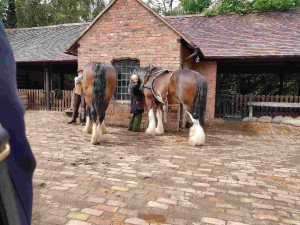 The shire horses also demonstrated that heavy haulage was still mainly horse powered. The extent of the 18th and 19th century enterprise here was clear from the ruins of the blast furnaces at the bottom of the town, and the sundry bits of iron machinery set up on the roadside, together with pigs and chickens to show that there was a domestic dimension to all this industry.
The shire horses also demonstrated that heavy haulage was still mainly horse powered. The extent of the 18th and 19th century enterprise here was clear from the ruins of the blast furnaces at the bottom of the town, and the sundry bits of iron machinery set up on the roadside, together with pigs and chickens to show that there was a domestic dimension to all this industry.
The schoolrooms, with their forms and desks and blackboards, 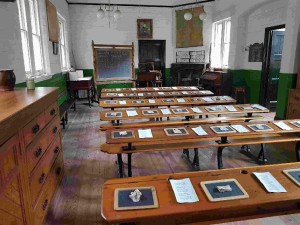 reminded a few of us of their own school days, although we had inkwells not slates. Various craftworkers demonstrated their skills such as woodcarving, and bread making. We moved on to see the iconic bridge, surprisingly high above the Severn, and now in a settlement whose existence is entirely due to its presence.
reminded a few of us of their own school days, although we had inkwells not slates. Various craftworkers demonstrated their skills such as woodcarving, and bread making. We moved on to see the iconic bridge, surprisingly high above the Severn, and now in a settlement whose existence is entirely due to its presence.
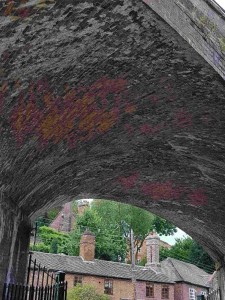 Ice cream was needed before our third and final stop at the Coalbrookdale Museum of Iron, re-opened in 2017, full of new exhibits explaining the development of ironworking and the history of the Coalbrookdale industrial complex. It is approached through an example of the wonderful brickwork achieved by Victorian engineers and builders – one of a series of skewed brick arches supporting a railway viaduct – although it proves an awkward access for today’s coaches. The museum’s objects and displays chart the increasing sophistication of ironworking technology, which was not always matched by a correspondingly sophisticated taste.
Ice cream was needed before our third and final stop at the Coalbrookdale Museum of Iron, re-opened in 2017, full of new exhibits explaining the development of ironworking and the history of the Coalbrookdale industrial complex. It is approached through an example of the wonderful brickwork achieved by Victorian engineers and builders – one of a series of skewed brick arches supporting a railway viaduct – although it proves an awkward access for today’s coaches. The museum’s objects and displays chart the increasing sophistication of ironworking technology, which was not always matched by a correspondingly sophisticated taste.
In the museum precincts is an excavated example of a blast furnace, preserved under a modern tent-shaped structure. The remains are a serious four-dimensional challenge to work out the spatial and temporal jigsaw presented inside, although the blast furnace itself is clear enough, and impressive.
The general feeling of our group was that we could have spent more time in each of our stops, yet we only visited three of the ten historical attractions that make up the Ironbridge Gorge museum complex, spread over several miles of the valley. Our thanks are due to Isobel Gill for arranging such an absorbing trip.
World War 2 Oral Histories. A website founded by broadcaster and historian, Dan Snow, and author and broadcaster, James Holland, WarGen (http://wargen.org) is a crowd-sourced online repository of oral-history from the people who lived through World War 2. As well as containing varied stories from this fast disappearing generation, this group is now looking for individuals to join their volunteer team as interviewers in their local communities. They are also eager to hear from people who might have their own stories to tell. If you are interested in either becoming an interviewer or sharing your story, please contact Shane Greer at shane@wargen.org
KDLHG Committee Matters.
At the Committee meeting on Monday 16st of September we heard the good news that our Treasurer Ted Crofts had finally managed to quarry some cheque books out of the HSBC, albeit with the wrong name – hey ho! Peter Ashley-Smith’s collected essays “Capturing Kineton’s Past” is in print. It is priced at £9.99 and members and friends are invited to a launch party in the Village hall at 7.30pm on Friday October 4th for drinks and nibbles. We discussed a provisional speaker list for 2020-21 and suggestions for outings, including an overnight to Rochester, to be canvassed at the next meeting (20.09.19). The Christmas 2019 meeting arrangements were discussed, including a proposed Christmas entertainment by Peter Waters, which was unanimously applauded. Peter continues to work on it. The plans for the proposed archive room in the Village Hall have been approved by the District planning and building control authorities, but our estimates need to be revised upwards to accommodate some conditions relating to fire regulations. This may mean some fund raising will be necessary. The timetable for construction is now set to be in the new year, leaving a gap when the Ashley-Smith archive will require temporary housing. The practicability of short term storage at a facility in Pillerton Priors is being explored. Roger Gaunt continues to scan material from the A-S archive, and will be provided with an external hard drive to store the large files. The churchyard survey database has been discussed with the Jim Saxton and the church authorities, who are moving the church website to a server which is not compatible with the churchyard database. The database will stay as it is, with a link to the church webpage, but it needs updating. DB continues to monitor the KDLHG emails and has reported enthusiastic appreciation of the churchyard database from family history researchers. There is still a vacancy for the roles of Secretary and Programme Organiser.
Next committee meeting. There will be a brief meeting of the committee after the book launch on 4th October, and a full meeting on 18th November at 7.30, at Catherine Petrie’s home.
DF 17.09.19